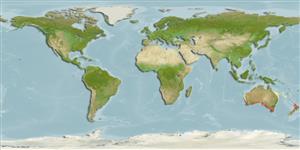>
Eupercaria/misc (Various families in series Eupercaria) >
Labridae (Wrasses)
Etymology: Notolabrus: Greek, noton = back + Greek, labros = voracious (Ref. 45335); tetricus: Specific epithet meaning grim, referring to the rather forbidding appearance of large terminal phase individuals..
More on author: Richardson.
Environment: milieu / climate zone / depth range / distribution range
Écologie
marin récifal; profondeur ? - 50 m (Ref. 9563). Temperate
Southwest Pacific: restricted to southeastern Australia, from New South Wales to South Australia, including Tasmania.
Taille / Poids / Âge
Maturity: Lm ? range ? - ? cm
Max length : 50.0 cm TL mâle / non sexé; (Ref. 9563)
Found on rocky reefs (Ref. 9563).
Life cycle and mating behavior
Maturities | Reproduction | Spawnings | Egg(s) | Fecundities | Larves
Oviparous, distinct pairing during breeding (Ref. 205).
Russell, B.C., 1988. Revision of the labrid fish genus Pseudolabrus and allied genera. Rec. Aust. Mus. (Suppl. 9):1-72. (Ref. 26203)
Statut dans la liste rouge de l'IUCN (Ref. 130435)
Menace pour l'homme
Harmless
Utilisations par l'homme
Outils
Articles particuliers
Télécharger en XML
Sources Internet
Estimates based on models
Preferred temperature (Ref.
123201): 14.3 - 20.6, mean 17.5 °C (based on 130 cells).
Phylogenetic diversity index (Ref.
82804): PD
50 = 0.5078 [Uniqueness, from 0.5 = low to 2.0 = high].
Bayesian length-weight: a=0.01995 (0.00922 - 0.04317), b=2.99 (2.79 - 3.19), in cm total length, based on LWR estimates for this (Sub)family-body shape (Ref.
93245).
Niveau trophique (Ref.
69278): 3.6 ±0.5 se; based on size and trophs of closest relatives
Résilience (Ref.
120179): Faible, temps minimum de doublement de population : 4,5 à 14 années (Preliminary K or Fecundity.).
Fishing Vulnerability (Ref.
59153): Moderate vulnerability (40 of 100).
Nutrients (Ref.
124155): Calcium = 12.1 [5.2, 22.1] mg/100g; Iron = 0.176 [0.091, 0.394] mg/100g; Protein = 18.4 [15.7, 20.8] %; Omega3 = 0.263 [0.137, 0.519] g/100g; Selenium = 7.81 [3.56, 17.29] μg/100g; VitaminA = 39.3 [8.8, 240.8] μg/100g; Zinc = 0.519 [0.327, 0.974] mg/100g (wet weight);
